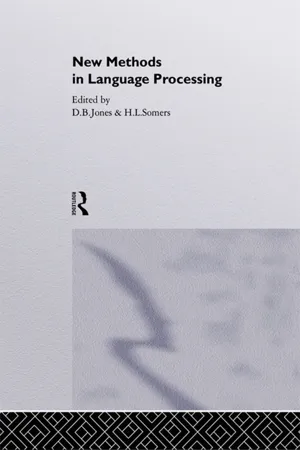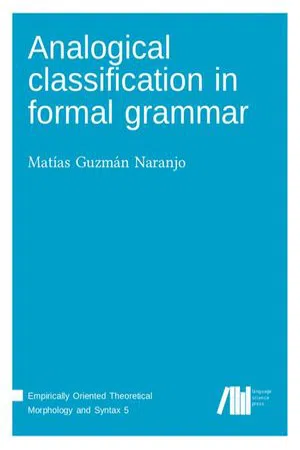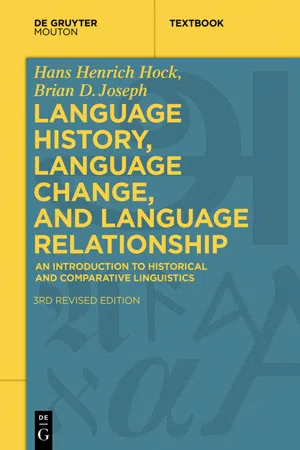Languages & Linguistics
Faulty Analogy
Faulty analogy is a logical fallacy that occurs when a comparison is made between two things that are not actually alike in relevant ways. This type of argument can be misleading and can lead to false conclusions. In language and linguistics, faulty analogies can lead to misunderstandings and inaccurate comparisons between different languages or language features.
Written by Perlego with AI-assistance
Related key terms
1 of 5
3 Key excerpts on "Faulty Analogy"
- eBook - ePub
- D. B. Jones, H. Somers(Authors)
- 2013(Publication Date)
- Taylor & Francis(Publisher)
In other words, linguistic analogy involves symbolic objects as a whole, or, put in a nutshell, linguistic analogy is a symbolic relationship. This assumption has important consequences on the working of analogy as such. In our system (see Fig. 2.2), there is no possible way of matching, say, red and spotted, since there is no shared part of their linguistic representation that would license the extraction of a common ending core (- ed in this case). Figure 2.2 Illegal analogical matching. Having defined the necessary condition for a linguistically relevant analogy to be looked for, in the next section we move on to a consideration of the possible ways in which the analogy in question can be extracted. The matching algorithm Any formalized notion of linguistic analogy must address the problem of how to match a new, unknown form of a base object (say a word form which had never before been encountered by the system) with already known forms of the same kind (e.g. word forms about which the system has already acquired some knowledge). For what concerns us here, this sort of matching applies to strings of characters, as opposed, say, to phonological segments - eBook - PDF
- Matias Guzmán Naranjo(Author)
- 2019(Publication Date)
- Language Science Press(Publisher)
2 Remarks on analogy Analogy can be defned in many ways, and it can be ascribed to various kinds o f processes. Te literature on analogy is vast and covers all sorts of phenomena and domains. Most work on it focuses on phenomena that are not directly relevant to the overall question of this book, but which are related in some way or another. In linguistics, the term analogy is usually employed whenever a process makes reference to direct comparison of surface items without making use of general rules, or when phonological or semantic similarities are involved, which are not easily captured as categorical generalizations. However, as a concept, analogy is rather fuzzy, and has no precise or unique de fnition. In the following subsections, I briefy mention some o f the di ferent phenomena for which the term analogy has been used, and in the fnal section o f this chapter I focus on the actual kind of systems I will address in the present book. Making justice to the history of analogy in linguistics would require a book (or several) of its own. Extensive discussions of the development of analogy as a concept in linguistics can be found in An tila (1977), Rainer (2013) and, mos t extensively, Itkonen (2005). 2.1 Te many meanings of analogy 2.1.1 Single case analogy Te simplest form of analogy is a similarity relation between two single items that plays a certain role in triggering or blocking a phonological or morpholog-ical process. An example of this type of analogy has been proposed to explain unpredictable new coinages and neologisms that make use of unproductive mor-phemes or non-morphemes (Motsch 1977: 195, see also Bu terwor th 1983). In such cases, a newly coined form does not make use of any derivational morphologi-cal process but is directly built on the basis of some existing form instead. Booij (2010: 89) cites the examples in (1): (1) a. angst-haas → paniek-haas fear-hare panic-hare ‘terrifed person’ → ‘panicky person’ - eBook - PDF
Language History, Language Change, and Language Relationship
An Introduction to Historical and Comparative Linguistics
- Hans Henrich Hock, Brian D. Joseph(Authors)
- 2019(Publication Date)
- De Gruyter Mouton(Publisher)
False analogy was considered characteristic of late, decaying languages. One of the great achievements of the neogrammarians, generally overshad-owed by the fame of their regularity hypothesis, was the insistence that such notions as decay and false analogy are inappropriate in historical linguistics. Reconstructed languages and their early offshoots should not be considered any more perfect than later, or even modern, descendants. There is no indication whatsoever that speakers of ancient Greek (or, we might add, Old English) were able to communicate any more effectively than speakers of Byzantine or Modern Greek (or of Modern English). Similarly, the neogrammarians argued, all linguis-tic phenomena encountered in observable history must be accepted as possible in reconstructed Proto-Indo-European as well, or in its early descendants. This view, which liberated historical linguistics from earlier, prescientific ideas, has 142 Analogy and change in word structure since become known as the uniformitarian hypothesis, a term borrowed from geology where the notion of uniformitarianism brought about a similar revolution in thinking. Consequently, changes of the type cow : kine → cow-s could no longer be claimed as limited to late, “decaying” languages, but had to be accepted as a pos-sibility at all stages of linguistic development. This change in perspective led to the rejection of the term “false analogy” and its replacement by the simple term analogy. Note, however, that as a consequence of this relabeling, the term analogy underwent a considerable change in meaning, from “pattern” or “regularity” to something like “change in phonetic shape conditioned by non-phonetic factors in other lexical items, such as word structure, syntactic function, and semantics”. Analogical change, as defined now, tends to introduce greater phonetic similarity between semantically, formally, or functionally similar linguistic forms.
Index pages curate the most relevant extracts from our library of academic textbooks. They’ve been created using an in-house natural language model (NLM), each adding context and meaning to key research topics.


